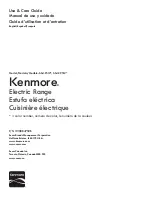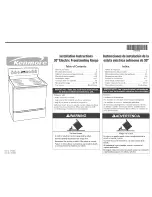
S
PECIFICATIONS
M
ODEL
400 R
ESTAURANT
R
ANGES
P
AGE
10
OF
64
O
PERATOR
’
S
M
ANUAL
1182299
REV
3 (05/05) D
RAFT
SPEC
IFICATIONS
This appliance should be connected ONLY to the type of gas for which it is equipped.
An adequate gas supply is imperative. Undersized or low pressure lines will restrict the volume of gas
required for satisfactory performance. Fluctuations of more than 25% on natural gas or 10% on propane gas
will create problems and affect burner operating characteristics. A 1/8" pressure tap is located on the
manifold to measure the manifold pressure.
An adequate gas supply line to the unit should be no smaller than the inside diameter of the pipe from the
unit to which it is connected.
Purge the supply line to clean out dust, dirt, or other foreign matter before connecting the line to the unit.
All pipe joints and connections must be tested thoroughly for gas leaks. Use only soapy water for testing on
all gases. NEVER use an open flame to check for gas leaks. All connections must be checked for leaks after
the unit has been put into operation. Test pressure should not exceed 14" W.C.
ELECTRICITY SUPPLY
Units with a convection oven require connection to a supply of electricity. The appliance, when installed,
must be electrically grounded in accordance with local codes, or in the absence of local codes, with the
National Electrical Code, ANSI/NFPA 70,
or the
Canadian Electrical Code, CSA C22.2,
as applicable. An
electrical diagram is located on the rear of the range, near the motor.
Usually the range is furnished with one or two power cords (one for each oven), each with a standard 115V
60Hz single-phase prong plug. Total maximum amps for 115V units is 12.5.
The range can be ordered to operate on 208V 60Hz 1-phase or 3-phase current, in which case the electric
power supply must be wired to one or two junction boxes (one for each oven), each with a terminal block on
the rear of the range. Total maximum amps for 208V units is 8.1.











































